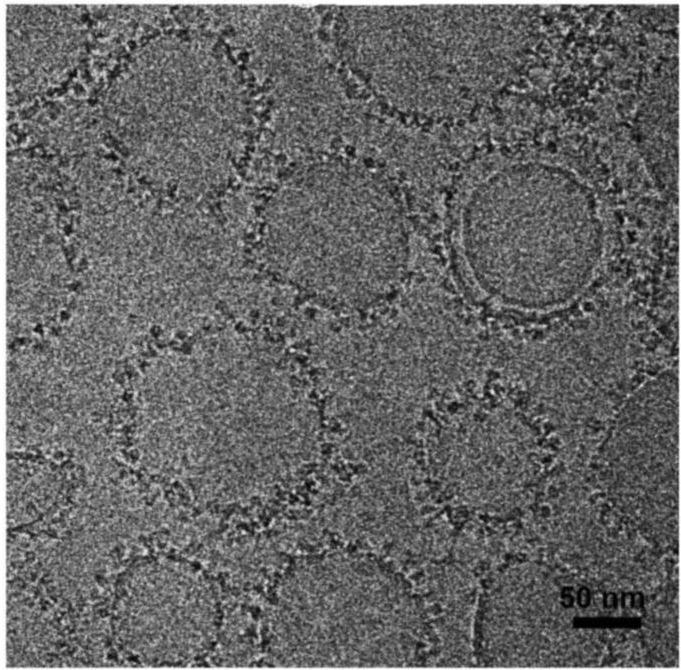May 25 2021
Preclinical studies have demonstrated the effectiveness of an experimental flu vaccine that contains scores of microscopic spherical sacs carrying infection-fighting proteins all through the body.
 The circle-shaped objects in the image above are cobalt-porphyrin-phospholipid (CoPoP) nanoparticles decorated with flu proteins. Image Credit: University at Buffalo.
The circle-shaped objects in the image above are cobalt-porphyrin-phospholipid (CoPoP) nanoparticles decorated with flu proteins. Image Credit: University at Buffalo.
As explained in a study recently published in the Proceedings of the National Academy of Sciences on May 24th, 2021, the experimental flu vaccine can:
- Enhance the effectiveness of seasonal flu vaccines, which generally work 40% to 60% of the time, as per the U.S. Centers for Disease Control and Prevention
- Use smaller doses, thus boosting vaccine supplies, which can be crucial considering the unforeseeable nature of influenza
- Take less time to generate large amounts because it is different from a majority of seasonal flu vaccines and is produced in embryonated chicken eggs
The results are very encouraging. Typically, flu vaccines contain either deactivated microbes that cause influenza, or they are based on weakened forms of the disease. The vaccine we’re developing is a recombinant protein nanoparticle vaccine that stimulates a strong immune response.
Jonathan Lovell, PhD, Study Senior Author and Associate Professor of Biomedical Engineering, University at Buffalo
Crucial to the success of the vaccine is a liposome, known as cobalt-porphyrin-phospholipid, or CoPoP, produced by Lovell and collaborators.
Such small spherical sacs, which are sufficiently small to be regarded as nanoparticles, represent the backbone of the so-called pharmaceutical parlance as a vaccine platform, which is any fundamental technology used to design numerous vaccines.
While the platform is not part of this analysis, it is being used as a COVID-19 vaccine candidate in clinical trials in South Korea. This is a collaboration between POP Biotechnologies—the University at Buffalo spinoff company co-founded by Lovell—and a South Korean biotech firm called EuBiologics. POP Biotechnologies is also closely working with Scripps Research to analyze the platform in a potential HIV vaccine.
When used alone, such liposomes do not combat the disease. However, they have a unique ability—that is, they spontaneously transform virus proteins that promote immune reactions into a more powerful nanoparticle format.
This conversion is advantageous because the dissolved proteins attach to the surface of the liposomes, where the proteins enhance the immune system’s response to disease.
Matthew Miller, PhD, Study Senior Author and Associate Professor of Biochemistry and Biomedical Sciences, McMaster University
In this analysis, the team introduced a class of proteins, called hemagglutinin, to the CoPop liposomes. And one specific hemagglutinin, referred to as trimeric H3 HA, activated a powerful immune reaction in mice.
“The nanoparticles carry the trimeric H3 HA to the body’s immune cells, and they provoke those immune cells to respond more vigorously to the flu,” stated Zachary Sia, the study lead author and PhD candidate in Lovell’s laboratory.
In experiments that involved the flu viral strain H3N2, blood serum collected from vaccinated mice was administered to non-vaccinated mice. This injection protected the animals from H3N2. In experiments with ferrets that involved a more contemporary H3N2 strain, the vaccine decreased the quantity of virus in the upper respiratory system of the animals.
Even in the case of doses down to 2 ng, the vaccine offered almost the same level of protection as that of vaccines with doses usually quantified in micrograms, or around 1000 times more.
The dose-sparing effect is important because it means we could create many more doses using less materials Simply put, CoPoP likely will provide greater immune protection with less hemagglutinin than current vaccines.
Bruce Davidson, PhD, Study Senior Co-Author and Associate Professor of Anesthesiology, Jacobs School of Medicine and Biomedical Sciences, University at Buffalo
The new vaccine platform is also multipurpose.
The team was able to concurrently bind a total of 10 recombinant proteins that represent distinct influenza viral strains to produce a highly multivalent nanoparticle. A 5-ng dose in mice provided protection against the H5N1 flu strain, generally called bird flu—a virus that has the ability to set off a pandemic, according to epidemiologists.
The study was funded by the U.S. National Institutes of Health, the Canadian Institutes of Health Research (CIHR) New Investigator Award from the Government of Ontario, a Physicians Services Inc. Research Trainee Fellowship, and a CIHR Canada Graduate Scholarship.
More support was provided by the Veterans Affairs Western New York Healthcare System, the Canadian Foundation for Innovation, the Facility for Electron Microscopy Research at McGill University, and the Government of Quebec.
Lovell and Wei-Chiao Huang, the co-author of the study, hold interest in POP Biotechnologies.